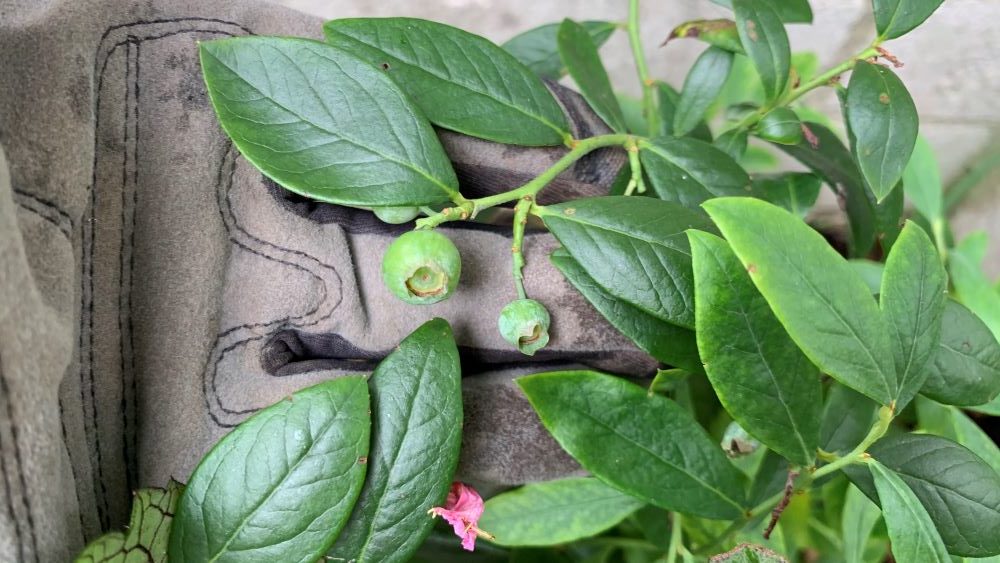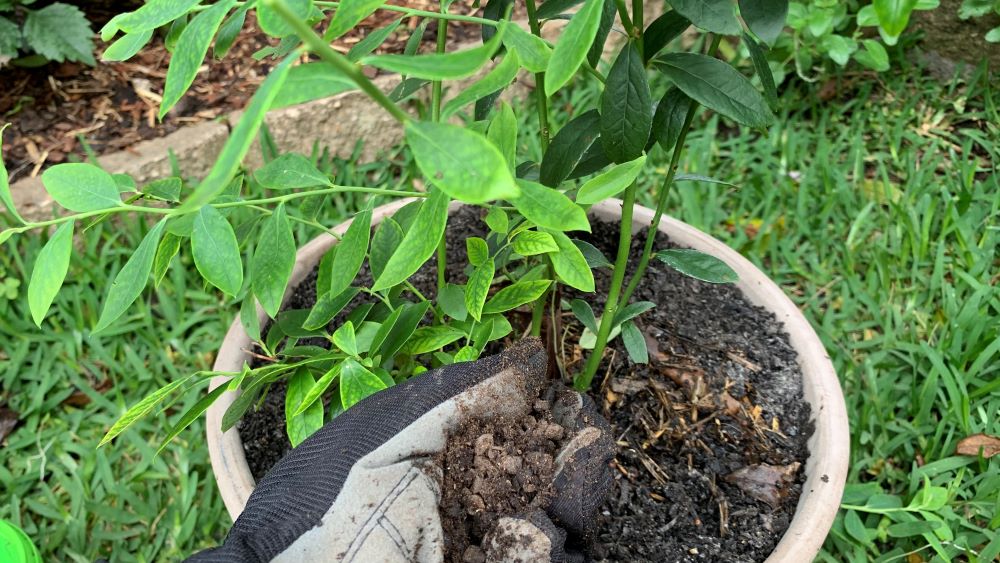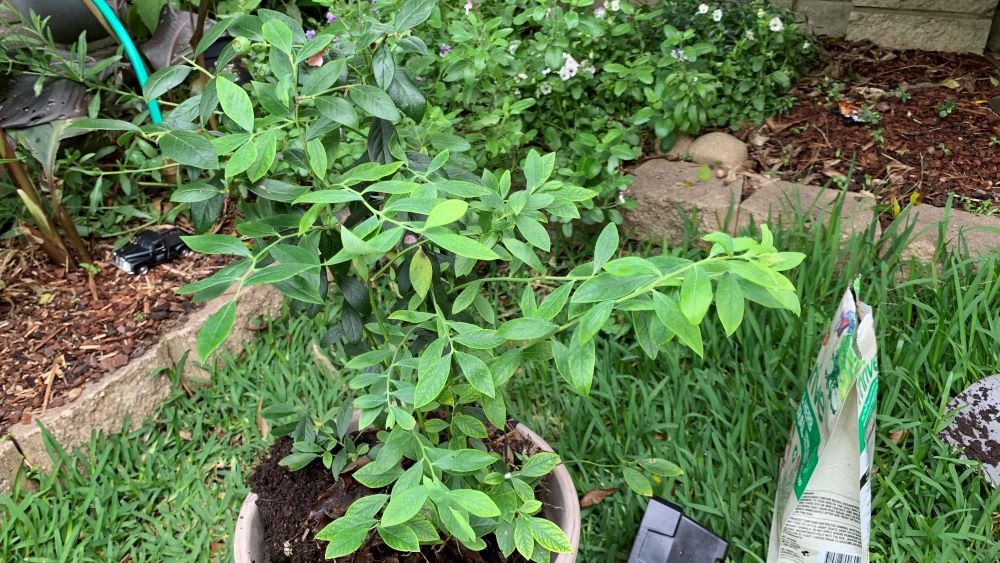Dying potted blueberry plants can be saved if you work out the problem. If your blueberry plant has brown or yellow leaves, if the leaves are falling off or the branches are dying then it is time to act. Keeping the soil moist but not wet, fertilizing once per year and repotting when it has outgrown its pot.

This article will explore the signs that your potted blueberry plant is dying and how to save it.
Signs that your potted blueberry plant is dying
Here are the top 4 signs that your blueberry plant is dying and what causes each problem.
1. Blueberry leaves are turning brown
If you notice that your blueberry plant leaves are turning brown then it is suffering. Brown leaves can be a sign that the plant is lacking nitrogen, the soil is too dry it could have suffered frost damage or pest attack.

2. Losing leaves
Blueberry plants can lose their leaves after they turn brown. If you notice that leaves are dropping from your blueberry then they may have become dry due to underwatering, have been frozen in a frost or eaten by caterpillars.
If the leaves are brown on the edges with bite marks, this is a sure sign that your leaves have been eaten by caterpillars, slugs or snails. If the whole leaf is brown it is more likely to be related to a lack of water or frost.
3. Blueberry bush branches dying
Blueberry bushes with whole branches that are dying have reached the next stage of damage. If the plant is too dry and after the leaves have turned brown, the whole branch can brown and die off. If the branch has been broken or damaged it will turn brown and die off.
4. Blueberry leaves turning yellow
Yellow leaves on blueberry plants can be a sign that the plant is suffering. Yellow leaves are usually a sign of a lack of nitrogen or overwatering. Too much water can wash away the nitrogen turning the leaves yellow.

Top causes of a dying potted blueberry plant
Here are the top causes of damage to a potted blueberry plant and what to do to solve each one.
1. Too much water
Overwatering can cause the blueberry plant to lose nitrogen, cause the roots to rot and cause damage to the leaves. While blueberry plants like moist soil, too much water can make the potting soil lose its oxygen and nutrients. The soil can become dense and anaerobic.
To solve this problem you need to slow down your watering schedule. Watering the pot once every 4 days during summer when there is low rainfall will be fine. Reduce this to once per week during the cooler months.
If the soil has become compact, has dropped in level or has mold growing on the surface it is a good idea to repot the plant. Take the blueberry bush out of the pot and let the excess potting soil drop away.
Choose a new pot for your blueberry or clean the pot that it was in. Get some fresh, good quality potting soil and repot the plant. Water it in well to move the soil around the roots.
2. Not enough water
Potted blueberry plants that have been allowed to dry out can develop brown leaves and dying branches. Test the potting soil with your finger and if it is dry 2 inches down thoroughly water your plant.
To thoroughly wet your blueberry, you can sit it in a bucket of water with a dash of seaweed. Fill the bucket up with water, slightly below the top of the pot. Let the pot sit in the water for 5-10 minutes until it soaks through.
3. Too much fertilizer
Blueberry plants can be sensitive to too much fertilizer. While it is important to fertilize them once per year in spring, too much can cause damage. You may notice brown or yellowing leaf tips and edges if the plant has too much fertilizer.
To fix the problem remember to only add fertilizer to your plant in spring. Use an all-purpose fertilizer like pelleted chicken manure and water it in well. If your plant has too much fertilizer consider repotting the plant into fresh potting soil if the damage is continuing.

4. Not enough sun
Blueberries are sun loving plants and if they are not getting enough, they will start to suffer. You may notice yellowing leaves and the plant will not produce flowers and berries. My blueberry plant was smothered by a nearby plectranthus so it was time to dig it out and move it.
While the blueberry plant was still growing well it wasn’t producing any more flowers and fruit after being covered up. I have now moved it to a new pot and into a brighter position. It gets morning sunlight and afternoon shade which will protect the leaves and fruit from burn in summer.

6. Old soil
A blueberry plant that has been left in the same pot for 2-3 years can start to suffer. Over this amount of time the potting soil will start to compact and lose oxygen. This can cause the plant growth to slow and it will struggle to grow berries.
Replace the soil and repot the plant every 2-3 years to freshen up the soil and add back air and nutrients. This will allow the small roots of the plant to regrow and access new nutrients.

How to save a dying potted blueberry plant | Summary
Save your dying potted blueberry plant by check to see if it is too wet, too dry or if it is time to repot the plant. Move it into a fresh, clean pot with new potting soil and fertilize the plant once per year with pelleted chicken manure.
Water the plant well, keeping the soil moist but not too wet. Allow the water to drain out the bottom of the pot before potting it on a pot tray or skip the pot tray all together to let it drain well.
Happy growing.
I am an accredited practicing dietitian, experienced gardener and a dedicated cook. I love writing and sharing my experience so you can learn from my successes and mistakes.
